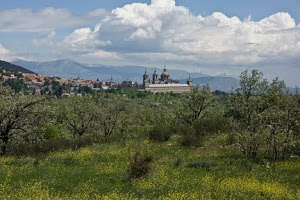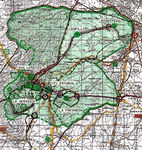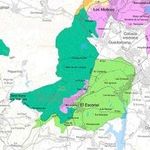Collaborative Design Planting Design Working Group 24: Difference between revisions
| Line 100: | Line 100: | ||
''* Please add internet links to other resources if necessary.'' | ''* Please add internet links to other resources if necessary.'' | ||
''' | '''External links''' | ||
'''Nature'''[http://www.sanlorenzoturismo.org/ingles/entorno_natural/entorno_natural.asp] | '''Nature'''[http://www.sanlorenzoturismo.org/ingles/entorno_natural/entorno_natural.asp] | ||
Revision as of 03:31, 17 January 2014
---> back to group page working group 24
Landscape at the Historical Site of El Escorial (Spain)
| Name | Landscape of the historical Cerca Real (Royal Wall) Territory at El Escorial | |
| Location | El Escorial (Madrid) | |
| Country | Spain | |
| Authors | Francisco Felipe-Martínez, Le Trang Nguyen, Irina Slobozeanu | |

| ||
|
| ||
Landscape and/or urban context of your case
- Biogeography, cultural features, overall character, history and dynamics
In the XVIth. Century, when the Royal Monastery of St. Lawrence at El Escorial was built by Philipp II (the contruction of the 4 Ha building took from 1563 to 1584) the same king decided to enclose the whole Monastery lands and related territories, as well as several already existing or new constructed palaces and mannors, by a 55 km long granite and gneis stone wall(Gran Cerca or Pared Real). It was renovated in 1793. The Monastery and related palaces, mannors and lands inside this historical territory include some of the most relevant renacentist and neoclassical gardens in Spain and the landscape has been an important issue since Philipp II, who was a passionated lover of Nature and gardens, organising mayor planting operations in the mountains in different parts of Spain, and creating gardens and orchards in all his mayor palaces and residencies.
In 1961 a part of it, the Mount Abantos, got the protection figure of Picturesque Landscape. The UNESCO entitled the Royal Monastry and Historical Site of El Escorial as World Heritage Site in 1984; nevertheless, part of the territory had not a real protection and underwent several contructions in the following decades. In 1995 la Herrería oaks, maple, ash-trees and sweet chestnuts forest was declared a Forest of Special Ecological Interest. In 2006 the Regional Government of Madrid entitled the Royal Wall and the whole land, forests, archeological settlements, monuments and gardens within, as Cultural Protected Item (BIC) as Historic Territory. The place is also part of the European Nature 2000 LIC site of the Guadarrama river.
- Maps
What are the objectives of your design?
Please give a short written argumentation (not more than 150 words). It is ok if you have different or even contradicting objectives within your group. Just make it explicit at the beginning of your process
Analytical drawings
Please add four analytical sketches/drawings (or montages/schemes) of your case. Every group member needs to contribute at least one drawing.
- Analytical Drawings
- Yourfilename1.jpg
analytical drawing 1
- Yourfilename2.jpg
analytical drawing 2
- Yourfilename3.jpg
analytical drawing 3
- Yourfilename4.jpg
analytical drawing 4
Projective drawings
Please add four projective sketches/drawings (or montages/schemes), of course with an emphasis on planting design/vegetation aspects. Every group member needs to contribute at least one drawing representing his/her individual ideas.
- Projective Drawings
- Yourfilename1.jpg
projective drawing 1
- Yourfilename2.jpg
projective drawing 2
- Yourfilename3.jpg
projective drawing 3
- Yourfilename4.jpg
projective drawing 4
Design Synthesis
Please analyse the individual approaches presented so far and evaluate their strengths and weaknesses (you may use the SWOTanalysis model). Try to create a synthesis and represent it with a plan and some sketches. You can still use drawings/sketches.
- Design Synthesis Drawings
- Yourfilename1.jpg
synthesis drawing 1
- Yourfilename2.jpg
synthesis drawing 2
- Yourfilename3.jpg
synthesis drawing 3
- Yourfilename4.jpg
synthesis drawing 4
Summary of the collaborative process
Please reflect on your collaborative design process. Which potentials have you encountered? What was most difficult? What does collaborative design mean for you? (approx 150 words).
Image Gallery
You may add a series of images/photos in addition to the sketches/drawings
- Image Gallery
- Yourfilename1.jpg
image 1
- Yourfilename2.jpg
image 2
- Yourfilename3.jpg
image 3
- Yourfilename4.jpg
image 4
References
* Please make sure that you give proper references of all external resources used.
* Do not use images of which you do not hold the copyright.
* Please add internet links to other resources if necessary.
External links
Nature[1] Historical Heritage[2] Royal Monastery of El Escorial[3] Monastery[4] Casita del Príncipe Palace, Gardens and Orchards[5] Casita del Príncipe[6] Casita del Príncipe Palace, Gardens, Orchards and Parc (extensive, in Spanish)[7] Casita del Infante Palace[8] Casita del Infante Gardens[9] Arboreto Luis Ceballos[10]
About categories: You can add more categories with this tag: "", add your categories

